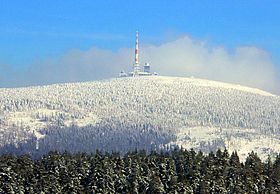Our website is made possible by displaying online advertisements to our visitors.
Please consider supporting us by disabling your ad blocker.
Brocken
| Brocken | |
|---|---|
 The summit of the Brocken, showing the transmitters | |
| Highest point | |
| Elevation | 1,142 m (3,747 ft) Normalhöhennull |
| Prominence | 856 m (2,808 ft) |
| Coordinates | 51°48′02″N 10°37′02″E / 51.80056°N 10.61722°E |
| Naming | |
| Pronunciation | German: [ˈbʁɔkən] |
| Geography | |
| Location | Saxony-Anhalt, Germany |
| Parent range | Harz |
| Climbing | |
| Easiest route | drive, hike and train |
The Brocken, also sometimes referred to as the Blocksberg, is a 1,141 m (3,743 ft) mountain near Schierke in the German state of Saxony-Anhalt, between the rivers Weser and Elbe. The highest peak in the Harz mountain range, and in Northern Germany, it is subalpine, yet has a microclimate resembling that of mountains nearly 1,000 m (3,300 ft) higher. The elevation above its tree line tends to have snowcover from September to May, and mists and fogs shroud it up to 300 days a year. The mean annual temperature is only 2.9 °C (37.2 °F). It is the easternmost mountain in northern Germany; the next prominent elevation directly to its east would be in the Ural Mountains in Russia.
The Brocken has always played a role in legends and has been connected with witches and devils; Johann Wolfgang von Goethe took up the legends in his play Faust. The Brocken spectre is a common phenomenon on this misty mountain, where a climber's shadow cast upon fog creates eerie optical effects.
Today the Brocken is part of the Harz National Park and hosts a historic botanical garden of about 1,600 alpine mountain plants. A narrow gauge steam railway, the Brocken Railway, takes visitors to the railway station at an elevation of 1,125 m (3,691 ft).
FM-radio and television broadcasting make major use of the Brocken. The old television tower, the Sender Brocken, is now used as hotel and restaurant. It also has an observation deck, open to tourists.
Previous Page Next Page



